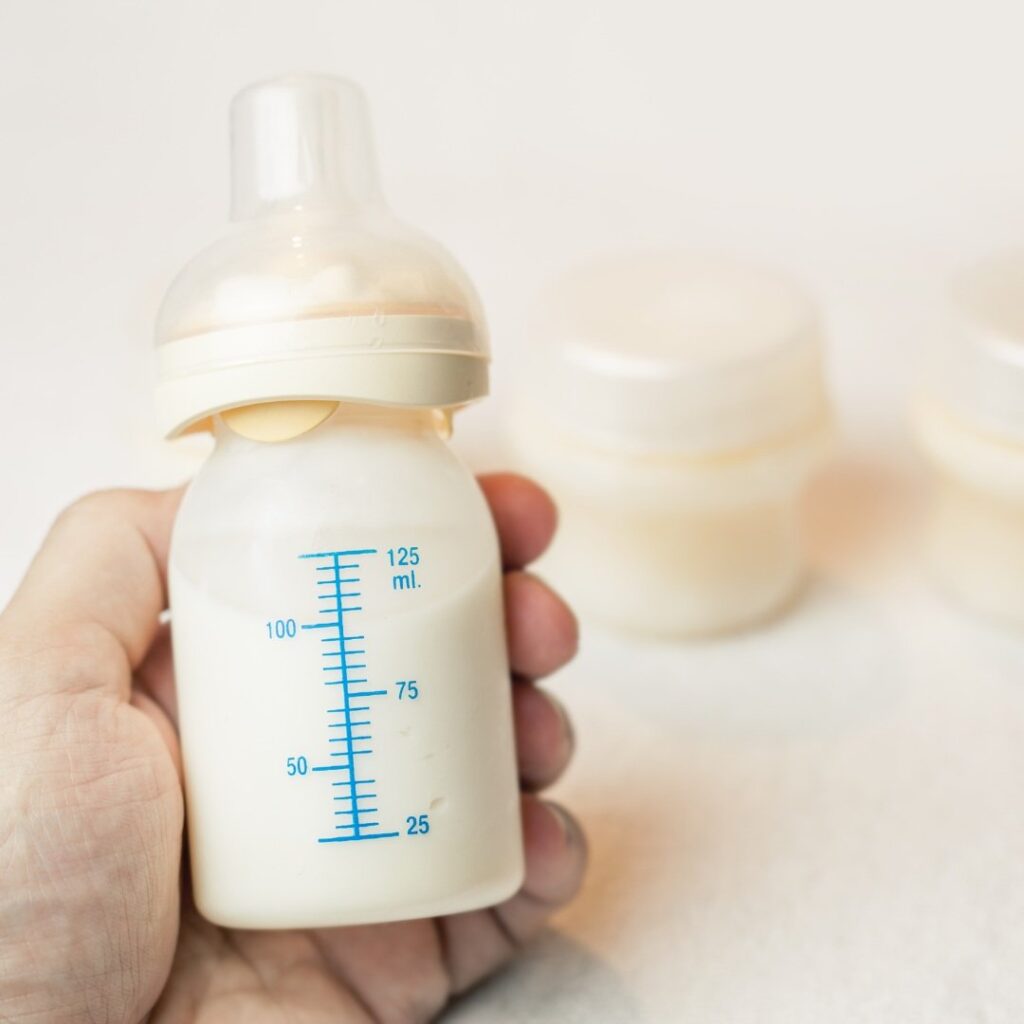1227 Rockbridge Rd. Suite 208, Unit 43 Stone Mountain, GA
A study on the role of melatonin, breast pumps, and breast milk.

Does the time of day it gets pumped impact the composition of breast milk? Yes, breast milk released at night contains more sleep-inducing nucleotides and Melatonin, which is present in more significant concentrations. On the other hand, breast milk released in the morning has higher concentrations of cortisol, a stress hormone that awakens infants.
Labeling breast milk with the time it was pumped if you are storing it and giving your infant “circadian-matched” milk is suggested. According to studies, feeding newborns milk “at the wrong time” can affect their circadian rhythm development and disrupt their sleep patterns.
According to “Chrono nutrition,” changing our eating habits can improve our daily rhythms and sleep cycles. While some dietary ingredients can make you more alert, others can make you drowsy. Similar to this, depending on when it is produced, breast milk may have either effect. Therefore, keeping note of the time the milk was expressed could become standard practice for moms who use breast pumps and save milk. They could give their infants milk made after dark when feeding them at night. To mimic the natural changes in breast milk, parents who use infant formula should also consider using various procedures slightly depending on the time of day.
Why can giving babies breast milk that is “circadian-matched” be advantageous? Melatonin, the hormone that causes drowsiness, is partially to blame for the solution. For instance, researchers tracked changes in breast milk over 24 hours in a trial of five breastfeeding moms in Israel, taking samples every two hours. The researchers concentrated on assessing melatonin levels, particularly how much of the hormone was present at night and during the day. Did the study find any variations between milk expressed at night and milk pumped during the day? It did, indeed. The scientists found a distinct circadian pattern, with breast milk produced after dark having a greater melatonin concentration. (Cohen Engler, an academic researcher et al. 2012).
These conclusions have been supported by additional research. For instance, researchers in a study of 21 nursing women in Germany found that melatonin levels were five times higher at night than during the day. (Katzer, Neonatology, and Pediatric Intensive Care MD et al. 2016). Similarly, during 24 hours, a research team in China found dramatic fluctuations in breast milk. The study compared the melatonin levels at 3 p.m., 9 p.m., and 3 a.m. in the milk of 98 nursing moms. (Qin, Department of Nursing, Medical College of Nursing, Huzhou University, Huzhou, People’s Republic of China, et al., 2019). Were melatonin levels typically about three times greater at 9 p.m. than at 3 p.m. Melatonin’s highest concentration level? 3 a.m. in the middle of the night. Compared to milk produced in the afternoon, breast milk expressed at this time contains almost ten times as much Melatonin.
Furthermore, studies have shown that the stress hormone cortisol, which might increase alertness, is present in higher concentrations in morning breast milk. Babies may suffer a rise in cortisol levels depending on when milk is produced.
Morning breast milk has cortisol concentrations that are roughly four times greater than evening milk (around 6 p.m.) and overnight milk. (Pundir et al., 2017; Italianer et al., 2020). Additionally, morning milk has nearly twice the amount of cortisol that milk consumed at night does.
Research has been conducted on the sleep-related effects of tryptophan.

Breast milk contains tryptophan, which the body uses to make Melatonin. The circadian rhythm regulates the rise and fall of tryptophan levels, which peak at night. (Caba-Flores, Doctor of Biomedical Research et al. 2022). There is some evidence that tryptophan in breast milk causes melatonin levels in babies to rise. In a study by Javier Cubero and colleagues, melatonin levels in 8 exclusively breastfed newborns were measured with changes in the mother’s breast milk. Additionally, they kept an eye on a control group of 8 infants fed formula. (Cubero, Researcher, et al. 2005).
Each infant was fed once every four hours when they were around 12 weeks old. There was, however, a distinction in the outcomes between the two groups. Breastfed babies’ melatonin levels peaked a few hours after the peak in their moms’ tryptophan levels. Infants fed on formula experienced a much later melatonin peak and slept for a smaller proportion of the night. It is unclear if the variations in melatonin cycles and sleep patterns were brought on by tryptophan in breast milk. Even if the association between maternal tryptophan and baby sleep patterns was not accidental, causation could not be established.
The differences observed in breastfed babies could also be explained by variables other than maternal tryptophan. Infants who were nursed, for instance, would have experienced more skin-to-skin contact, which might have reduced stress and enhanced sleep. The study’s breastfeeding mothers may have been more likely to expose their children to natural illumination patterns, facilitating their adjustment to the 24-hour day. Controlled experimental research, like the one carried out by Sara Aparicio and associates, is of interest for further understanding. This study used a double-blind, randomized experiment on babies who consumed formula to investigate the effects of dietary tryptophan. (Aparicio, Researcher et al., 2007).
In the study, there were three different circumstances. In the test set, babies were given conventional formula during the day and a tryptophan-enriched procedure at night. Infants receiving regular formula during the day and night were part of control condition #1. In control condition #2, infants received conventional formula at night and tryptophan-enriched procedures throughout the day (6 a.m. to 6 p.m.). (6 p.m. to 6 a.m.).
Following a week on the “night-time tryptophan” regimen, infants in the test condition demonstrated improved sleep patterns. In comparison, babies in the control groups did not exhibit such improvements.
Therefore, higher tryptophan levels during the day may help enhance young infants’ sleep quality.
Other sleepy ingredients?
Tryptophan and Melatonin aren’t the only nutrients found in breast milk; nucleotides like 5’UMP, 5’AMP, and 5’GMP induce sleep or control circadian rhythms. (Caba-Flores et al 2022; Sanchez et al., 2009). Breast milk contains these nucleotides, but do their concentrations change during the day?
Thirty women were asked to express their breast milk at various times throughout the day for the research by Cristina Sánchez and her associates. They discovered that the nucleotide concentrations in breast milk did change over a day. While 5’AMP, which causes drowsiness, was at its peak in breast milk released in the early evening, 5’UMP, which has a soothing effect, reached its peak concentration in the middle of the night.
Can we presume that these breast milk nucleotides will improve a baby’s ability to sleep through the night? More investigation is required to respond to this question. Some studies have used fortified foods with tryptophan and nucleotides to promote sleep. (Cubero 2006; Cubero et al. 2007). As a result, it is impossible to precisely identify how nucleotides affect babies’ sleep cycles on their own.
Does this mean that “mistimed” milk could affect an infant’s behavior?
Whether “mistimed” breast milk might affect an infant’s behavior needs further investigation, and the reality is probably complicated. But it is possible, as Jennifer Hahn-Holbrook and her associates have said. The Melatonin in breast milk swiftly diffuses into many organs, including the brain, after crossing the intestinal barrier, according to studies on animals. (Hahn-Holbrook et al., 2019). Furthermore, it is clear that glucocorticoids, including cortisol, can pass from breast milk to the developing brains of rodents, and there is evidence to suspect that humans can also experience this. (Hahn-Holbrook et al., 2019).
Additionally, scientists have discovered a link between “mistimed” breast milk and sleep. In a survey of more than 329 moms, Lauren Booker, and colleagues found a strong correlation between delayed breast milk expression and infants’ later bedtimes. (Booker et al., 2022). It seems reasonable to assume that the timing of breast milk production may be necessary, even during the first few minutes or hours after a baby feeds. According to Hahn-Holbrook and her team, frequently consuming “mistimed” breast milk could prevent newborns from developing healthy circadian rhythms, affecting their sleep patterns and stress reactions.
The good news is that, even if “mistimed” milk does cause issues, they may be quickly fixed by keeping note of the time of day that breast milk is released and avoiding feeding infants breast milk that is out of order chronologically.
Sources:
At Mothers Helping Hands Atlanta, we understand that parenting is not just about physical care—it’s also about nurturing the mental
As the fresh breezes and blooming flowers of spring signify new beginnings, it’s the perfect time for new and expectant
Mothers Helping Hands Atlanta LLC, a renowned provider of newborn and postpartum care and community health support, is proud

Copyright © 2023 Mothers Helping Hands Atlanta